◄ Carnets Geol. 14 (20) ►
Contents
[Introduction]
[Outcrops and material]
[Systematics] [Conclusions]
[Bibliographic references] [Plates] [Appendix 1] and ... [Appendix 2]
University of Silesia, Department of Earth Sciences, ul. Będzińska 60, PL 41-200 Sosnowiec (Poland)
Published online in final form (pdf) on December 24, 2014
[Editor: Bruno ;
language editor: Simon ]
Solitary or weakly colonial Phillipsastreid tetracorals of the Upper Frasnian of Holy Cross Mountains, Poland, with triangular to oval shape of transverse-section and tendency towards reduction of the horseshoe dissepiments, are included here in the genus Rozkowskaella, with Rozkowskaella sandaliformis, R. cf. sandaliformis and Rozkowskaella sp.
Rozkowskaella; Phillipsastreidae; Frasnian; Devonian; Holy Cross Mountains; Poland.
T. (2014).- Devonian Phillipsastreid tetracorals of the genus Rozkowskaella from the Holy Cross Mountains, Poland.- Carnets de Géologie [Notebooks on Geology], Brest, vol. 14, nº 20, p. 439-459.
Tétracoralliaires dévoniens du genre Rozkowskaella (Phillipsastreidae) des Monts Sainte-Croix, Pologne.- Des tétracoralliaires Phillipsastreidés solitaires ou ŕ peine coloniaux du Frasnien supérieur des Monts Sainte-Croix, en Pologne, avec une forme triangulaire ŕ ovale en section transversale et une tendance ŕ la réduction des dissépiments en fer ŕ cheval, sont placés ici dans le genre Rozkowskaella, avec Rozkowskaella sandaliformis, R. cf. sandaliformis et Rozkowskaella sp.
Rozkowskaella ; Phillipsastreidae ; Frasnien ; Dévonien ; Monts Sainte-Croix ; Pologne.
Жива, мертва ли - Иосиф / Бабочка |
Żywe czy zmarłe, Josif / Motyl |
All living creatures, Joseph / Butterfly |
The monotypic Devonian phillipsastreid genus Trigonella was introduced by in 1980 for the new Frasnian species Trigonella sandaliformis. In 1987, renamed the genus Rozkowskaella, due to homonymy of Trigonella , 1980, with Trigonella , 1778 (a modern bivalve). In 1991, and revised the original material of (1980), together with some newly collected specimens, and introduced Macgeea (Rozkowskaella) as a new subgenus, considering (after , 1989) the possible synonymy of the latter with Debnikiella , 1980. The similarity of these genera, if not their identity with Macgeea , 1889, was subsequently discussed by (2005, p. 18). The congeneric status of Rozkowskaella and Debnikiella is rejected in the present paper, due to fragmentary nature of the type material of the latter genus and due to the inaccessiblity of its type location for new sampling.
The Holy Cross Mountains in central Poland represent an area of gently folded Paleozoic deposits, elevated and exhumed during Cenozoic uplift episodes from beneath their Permo-Mesozoic cover. The Holy Cross Devonian carbonates, deposited in a subtropical shallow marine setting in Euroamerica, have been extensively studied for their fossils; some major recent contributions are listed in a table in Appendix 1.
The present author, during about 40 years of collecting of the Holy Cross Mountains rugose corals, collected, among thousands of other corals, about 20 or so specimens of solitary or rarely colonial, phillipsastreids with anomalous, triangular or oval transverse-cross sections. The first one was collected in 1976, during the course of gathering material for the author's M.Sc. Thesis, and found by Grzegorz at Góra Łgawa in Bolechowice. It was later offered to Maria , who described it in 1980 as a new phillipsastreid genus. Slowly and intermittently additional material came to light and was published. This paper is aimed at presentating all of this material and a discussion of some taxonomic questions; included are also some fragmentary specimens, referred to Rozkowskaella sp.
The studied specimens come from the Western - South-Western part of the Holy Cross Mountains
(Fig. 1 ![]() ). The rugose corals can be collected here mostly from active quarries, mining the massive biogenic limestones of the Givetian to Frasnian Kowala Limestone Formation, and their detrital and marly cover deposits
(Fig. 2
). The rugose corals can be collected here mostly from active quarries, mining the massive biogenic limestones of the Givetian to Frasnian Kowala Limestone Formation, and their detrital and marly cover deposits
(Fig. 2 ![]() ). According to
(1993a), the Holy Cross Devonian carbonate sequence represents here
a series of deepening Late Frasnian pulses, at the mobile shelf of southern Euroamerica. Rozkowskaella corals are rare and typically form minor admixture in
diverse coral associations in these outcrops - briefly presented below in
Appendix 2, with lists of the rugosan species / genera.
). According to
(1993a), the Holy Cross Devonian carbonate sequence represents here
a series of deepening Late Frasnian pulses, at the mobile shelf of southern Euroamerica. Rozkowskaella corals are rare and typically form minor admixture in
diverse coral associations in these outcrops - briefly presented below in
Appendix 2, with lists of the rugosan species / genera.
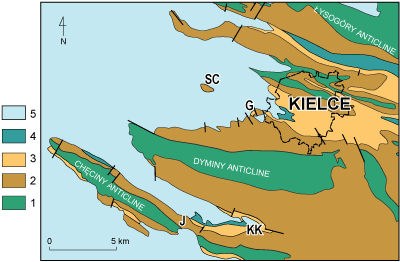
Click on thumbnail to enlarge the image.
Figure 1: Schematic geological map of the Devonian outcrop in the western part of the Holy Cross Mountains, with marked location of the outcrops with Rozkowskaella, described in the present paper (after , 1938, simplified and changed): G - Grabina, J - Jaźwica quarry, KK - Kowala quarry, SC - Szczukowskie Górki: 1 - Lower Paleozoic (Cambrian to Silurian); 2 - Lower and Middle Devonian; 3 - Upper Devonian; 4 - Lower Carboniferous; 5 - post-Variscan (Zechstein to Neogene) cover.
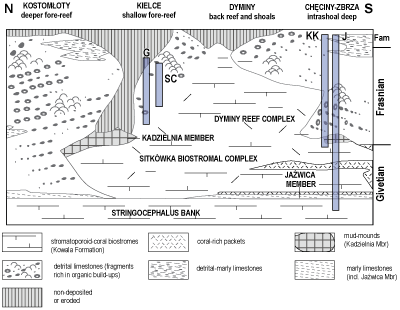
Click on thumbnail to enlarge the image.
Figure 2: Stratigraphy of the Rozkowskaella-bearing Devonian limestones in the western part of the Holy Cross Mountains (after
, 1993a), along the schematic North-South section;
outcrop codes as in Figure 1 ![]() .
.
Institutional abbreviations - paleontological collections
GIUS - University of Silesia, Department of Earth Sciences, Sosnowiec, Poland;
UAM - Adam Mickiewicz University, Institute of Geology, Poznań, Poland.
Family Phillipsastreidae C.F. , 1883
Genus Rozkowskaella , 1987
[type species Trigonella sandaliformis , 1980]
Diagnosis emended: solitary or colonial (dendroid, with few offsets) phillipsastreids with oval to triangular outline of corallites in transverse sections, with everted calicinal margins and with tendency to reduction of horseshoe dissepiments, particularly so in distal parts of mature corallites.
Synonymy list:
1980 Trigonella , p. 24, non Trigonella , 1778, p. 196 (a bivalve);
? 1980 Debnikiella , p. 25;
1987 Rozkowskaella , p. 277;
1991 Macgeea (Rozkowskaella) & , p. 10;
2011 Rozkowskaella , p. 194.
Remarks: Although Debnikiella , 1980, is a potential senior synonym to Rozkowskaella , 1987, the latter name is used, in apparent violation to the principle of priority. In fact Debnikiella is based on a single fragmentary specimen of Debnikiella formosa, reported by (1980, p. 25-26; Pl. 4, fig. 16) from the Dębnik area by Cracow (Silesian-Cracow Upland, Żarnówczany Dół quarry). This location is filled and overgrown, at least since the mid-1970s, and thus unavailable for new sampling. Consequently too little is known of Debnikiella formosa to make any taxonomic conclusions plausible, at least at this moment. It is also notable that a single specimen from the Upper Frasnian of Wietrznia, illustrated by (1980, Pl. 3, fig. 12, a transverse thin section), was also attributed to Debnikiella formosa (contrary to her statement at page 25, that the material of the species consists on one specimen), but most probably represents the genus Macgeea.
As kindly noted by R. in a review of the present paper, some material described below, especially the colony GIUS 388KK 328
(Pls. 2 ![]() - 3
- 3 ![]() - 4
- 4 ![]() - 5
- 5 ![]() - 6
- 6 ![]() ) is in some aspects similar to material of Pachyphyllum from the Frasnian of Western Canada. Indeed, some small colonies of Pachyphyllum miniaceum (
1986,
Figs. 48.14-48.19, at p. 450) display individual corallites rising 1 cm or slightly more above the massive part of
the colony; also some corallites seem to be oval to subtriangular in transverse section. In contrast to that, colony GIUS 388KK 328
has a distinctly dendroid aspect, and with a markedly triangular shape of the corallites, and
therefore appears taxonomically distinct from the Canadian material.
) is in some aspects similar to material of Pachyphyllum from the Frasnian of Western Canada. Indeed, some small colonies of Pachyphyllum miniaceum (
1986,
Figs. 48.14-48.19, at p. 450) display individual corallites rising 1 cm or slightly more above the massive part of
the colony; also some corallites seem to be oval to subtriangular in transverse section. In contrast to that, colony GIUS 388KK 328
has a distinctly dendroid aspect, and with a markedly triangular shape of the corallites, and
therefore appears taxonomically distinct from the Canadian material.
Rozkowskaella sandaliformis (, 1980)
1980 Trigonella sandaliformis sp. n.; , p. 24, Fig. 4; Pl. 2: 6a-c.
ep 1991 Macgeea (Rozkowskaella) sandaliformis (, 1980); & , p. 10, Pl. 1: 6-11, Pl. 2: 1-9; but not Pl. 1: 4, 5 - possibly a Diffusolasma.
ep 2011 Rozkowskaella sandaliformis (, 1980); , p. 194, Fig. 1:4A, 4B; but not Fig. 1: 1-3 - Rozkowskaella cf. sandaliformis.
Holotype: UAM Tc 1/13 (Pl. 1 ![]() ,
figs. 1a-1b) from the Upper Frasnian of Jaźwica quarry at Góra Łgawa in Bolechowice, SW Holy Cross Mountains, Poland.
,
figs. 1a-1b) from the Upper Frasnian of Jaźwica quarry at Góra Łgawa in Bolechowice, SW Holy Cross Mountains, Poland.
Material: seven specimens, all from the Upper Frasnian of the Holy Cross Mountains.
ID | remarks | outcrop details |
UAM Tc 1/13 | 4 peels - holotype | Jaźwica quarry R |
GIUS 402J 039 | 3 slides - topotype | Jaźwica quarry R |
GIUS 402J 057 | uncut / w offsets - topotype | Jaźwica quarry R |
GIUS 402J 139 | 3 slides - topotype | Jaźwica quarry R |
GIUS 365G 027 | 1 slide T - 40 peels | Grabina C |
GIUS 388KK 023 | 2 slides - 2 peels | Kowala quarry G |
GIUS 388KK 328 | 4 slides - 14 peels | Kowala quarry G |
Diagnosis: as for the genus.
Colony growth in GIUS 388KK 328: although offsets are rather common in the material studied, this specimen is notable for
the number and size of offsets; illustrated in
Pl. 2 ![]() , fig. 4, and in Pls.
3
, fig. 4, and in Pls.
3 ![]() - 4
- 4 ![]() - 5
- 5 ![]() - 6
- 6 ![]() is a series of acetate-peels, presenting some details of blastogeny in nine parallel sections,
which are cut roughly perpendicularly to the mother corallite;
is a series of acetate-peels, presenting some details of blastogeny in nine parallel sections,
which are cut roughly perpendicularly to the mother corallite;
1) a single, suboval mother corallite (Pl. 2 ![]() , fig. 4, to the right , seen here in its proximal part) can be seen at the base of this colony; it gives rise to a bundle of offset corallites, cut at odd angles to their axes in a series of eight parallel sections, following the first one;
, fig. 4, to the right , seen here in its proximal part) can be seen at the base of this colony; it gives rise to a bundle of offset corallites, cut at odd angles to their axes in a series of eight parallel sections, following the first one;
2) the lower of these (peels 2p and 3p in Pl. 3 ![]() , figs. 1a-1b respectively) contain the triangular mother corallite and two or three offsets seen laterally
to the mother, in longitudinal and obliquely-longitudinal sections; especially nice section is of the upper-left corallite in
Pl. 3
, figs. 1a-1b respectively) contain the triangular mother corallite and two or three offsets seen laterally
to the mother, in longitudinal and obliquely-longitudinal sections; especially nice section is of the upper-left corallite in
Pl. 3 ![]() , fig. 1b, with horseshoe dissepiments present in its proximal, and absent in its distal part;
, fig. 1b, with horseshoe dissepiments present in its proximal, and absent in its distal part;
3) the following peels 4Ap and 4p (Pl. 4 ![]() , figs. 1a-1b) display at right a very large lumen of mother corallite almost completely filled by basal parts of offsets, which probably originated at this level, subsequently growing to the sides and downwards of the mother, partly towards distal part of the latter, as seen in the following peels, which are
, figs. 1a-1b) display at right a very large lumen of mother corallite almost completely filled by basal parts of offsets, which probably originated at this level, subsequently growing to the sides and downwards of the mother, partly towards distal part of the latter, as seen in the following peels, which are
4) peels 5p and 6p (Pl. 5 ![]() , figs. 1a-1b) and peels 7p and 8p (Pl. 6
, figs. 1a-1b) and peels 7p and 8p (Pl. 6 ![]() , figs.
1a-1b), with transverse sections of distally growing offsets, with distinctly triangular shape; some offsets give rise to their own offsets (upper-right corallite in
Pls. 5
, figs.
1a-1b), with transverse sections of distally growing offsets, with distinctly triangular shape; some offsets give rise to their own offsets (upper-right corallite in
Pls. 5 ![]() - 6
- 6 ![]() , lower-center corallite in Pl. 6
, lower-center corallite in Pl. 6 ![]() ); in many places overflowing skeletal tissue can be seen expanding over
the older corallite periphery (especially so in the lower-center corallite in
Pl. 5
); in many places overflowing skeletal tissue can be seen expanding over
the older corallite periphery (especially so in the lower-center corallite in
Pl. 5 ![]() , fig. 1b and in
Pl. 6
, fig. 1b and in
Pl. 6 ![]() ).
).
Remarks: the studied material, and particularly the colony presented above, sheds new light on the possible adaptive significance of triangular corallite shape in Rozkowskaella, which has been regarded as an adaptation to life on a soft substrate ( & , 1991). However, in these sections it is seen to be erect, with distinctly triangular corallites of the colony, thus indicating another adaptive value of this peculiar shape, which probably involved flow regulation in the gastrovascular cavities of polyps of Rozkowskaella.
Rozkowskaella cf. sandaliformis (, 1980)
(Pl. 7 ![]() )
)
ep 2011 Rozkowskaella sandaliformis (, 1980); , p. 194, fig. 1: 1-3; but not fig. 1: 4 - Rozkowskaella sandaliformis.
Material: four specimens, all from the Upper Frasnian of the Kowala quarry in the Holy Cross Mountains.
ID | remarks |
GIUS 388KK 022 | 2 slides |
GIUS 388KK 046 | 2 slides - 10 peels |
GIUS 388KK 281 | 1 slide T |
GIUS 388KK 330A | 4 slides |
Remarks: these fragmentary specimens, with triangular or ovally-triangular sections, suppressed distal horseshoe dissepiments and with overflowing skeletal tissue
(Pl. 7 ![]() , fig. 4a) most probably belong to Rozkowskaella sandaliformis.
On the other hand, their dissepimentaria, especially so in GIUS 388KK 330A
(Pl. 7
, fig. 4a) most probably belong to Rozkowskaella sandaliformis.
On the other hand, their dissepimentaria, especially so in GIUS 388KK 330A
(Pl. 7 ![]() , figs. 2b
& 4c) suggest some similarity with the poorly known Debnikiella formosa ,
1980, from the Upper Frasnian of Dębnik, near Cracow, southern Poland (see remarks to the genus Rozkowskaella, above).
, figs. 2b
& 4c) suggest some similarity with the poorly known Debnikiella formosa ,
1980, from the Upper Frasnian of Dębnik, near Cracow, southern Poland (see remarks to the genus Rozkowskaella, above).
Rozkowskaella sp.
(Pl. 8 ![]() )
)
Material: 9 fragmentary specimens from the mid- and Upper-Frasnian of the Holy Cross Mountains.
ID | remarks | outcrop details | level |
GIUS 367SC 35A | 3 peels T | Szczukowskie Gorki | mid-Frasnian |
GIUS 367SC 77 | 1 slide T | Szczukowskie Gorki | mid-Frasnian |
GIUS 388KK 028B | 1 slide LT - 7 peels | Kowala quarry G | Upper Frasnian |
GIUS 388KK 069 | 1 slide T - 4 peels T | Kowala quarry G | Upper Frasnian |
GIUS 388KK 146 | 1 slide T - fragm | Kowala quarry G | Upper Frasnian |
GIUS 388KK 242 | 2 slides | Kowala quarry G | Upper Frasnian |
GIUS 388KK 248C | 2 sections LT T | Kowala quarry G | Upper Frasnian |
GIUS 388KK 316 | 1 slide T | Kowala quarry G | Upper Frasnian |
GIUS 388KK 339B | 1 slide L - budding | Kowala quarry G | Upper Frasnian |
Remarks:
1) two specimens from the mid-Frasnian of Szczukowskie Górki (Pl. 8 ![]() , figs. 1-2) are solitary, triangular phillipsastreids, and thus possibly close to Rozkowskaella sandaliformis; on the other hand this material is too fragmentary to make a firm statement possible;
, figs. 1-2) are solitary, triangular phillipsastreids, and thus possibly close to Rozkowskaella sandaliformis; on the other hand this material is too fragmentary to make a firm statement possible;
2) seven specimens from the Upper Frasnian of the Kowala quarry (Pl. 8 ![]() , figs. 3-9), are probable representatives of Rozkowskaella, but with oval rather than triangular outline
to the corallites, or with merely longitudinal sections that do not display a full set of diagnostic characters
for this genus.
, figs. 3-9), are probable representatives of Rozkowskaella, but with oval rather than triangular outline
to the corallites, or with merely longitudinal sections that do not display a full set of diagnostic characters
for this genus.
1) Among the numerous rugosans of the Givetian to Frasnian limestones of the Holy Cross Mountains, Poland, there are some rare solitary to weakly colonial Phillipsastreidae with triangular outline, which are here ascribed to the genus Rozkowskaella.
2) Phillipsastreid corals were relatively common and diverse in the Late Frasnian of the Holy Cross subtropical shelf of Euroamerica, and Rozkowskaella probably evolved here from its ancestors just prior to end-Frasnian events, which terminated the phylogenetic lineages of so much of the shallow-marine benthos, and among them the Phillipsastreidae.
3) Triangular outline of corallites is a genetically fixed character in Rozkowskaella, probably acquired during an earlier, unknown, phylogeny of the genus, and possibly linked with separation of fluids in gastrovascular cavities of its polyps. As it happens, the presence of flat external corallite surfaces could be a pre-adaptation for some solitary polyps of Rozkowskaella for life on a soft bottom, as in the Late Frasnian at the site of present day Jaźwica quarry.
My most sincere thanks go to the reviewers of the present paper, Marie and Ross - their critique allowed for improvements and corrections of the initial manuscript; Ms. M. has kindly prepared map and section in
Figs. 1 ![]() and 2
and 2 ![]() .
.
B. (2002).- Famennian Rugosa and Heterocorallia from southern Poland.- Palaeontologia Polonica, Warszawa, vol. 61, p. 3-87.
I. (1993, imprint 1992).- Trilobites from the Givetian and Frasnian of the Holy Cross Mountains.- Acta Palaeontologica Polonica, Warszawa, vol. 37, nº 2-4, p. 395-406.
M. & T. (1991).- Redescription of the rugose coral Macgeea (Rozkowskaella) sandaliformis ( 1980) from the Upper Frasnian of the Holy Cross Mountains (Poland).- Bulletin de l'Institut royal des Sciences naturelles de Belgique, Bruxelles, (Sciences de la Terre), vol. 61, p. 5-19.
J. (1938).- Ogólna mapa geologiczna Polski. Arkusz 4 (Kielce) [Carte géologique générale de la Pologne. Feuille 4 (Kielce)]; 1:100 000.- Państwowy Instytut Geologiczny, Warszawa.
Emanuel Mendes da (1778).- Historia Naturalis Testaceorum Britanniae or The British Conchology.- Millan, White, Elmsley & Robson, London, 254 p. (XVII Pls.) [in English and in French; available online at http://babel.hathitrust.org/cgi/pt?id=ucm.5329027802 - with few plates unnumbered and placed in odd sites of this copy of the book, held in the library of the Universidad Complutense de Madrid]
E. (1993).- Crinoid assemblages in the Polish Givetian and Frasnian.- Acta Palaeontologica Polonica, Warszawa, vol. 38, nº 1-2, p. 35-92.
B. (1993, imprint 1992).- Tentaculites from the Givetian and Frasnian of the Holy Cross Mountains.- Acta Palaeontologica Polonica, Warszawa, vol. 37, nº 2-4, p. 385-394.
J. (1971).- Morphogenesis and Systematics of the Devonian Stromatoporoidea from the Holy Cross Mountains, Poland.- Palaeontologia Polonica, Warszawa, vol. 26, 150 p. (41 pls.).
W. (2002).- Frasnian gastropod synecology and bio-events in the Dyminy reef complex of the Holy Cross Mountains, Poland.- Acta Palaeontologica Polonica, Warszawa, vol. 47, nº 2, p. 267-288.
J. & G. (1993, imprint 1992).- Ichthyoliths and deepening events in the Devonian carbonate platform of the Holy Cross Mountains.- Acta Palaeontologica Polonica, Warszawa, vol. 37, nº 2-4, p. 407-426.
J. & G. (1993, imprint 1992).- Givetian and Frasnian ostracod associations from the Holy Cross Mountains.- Acta Palaeontologica Polonica, Warszawa, vol. 37, nº 2-4, p. 359-384.
R.A. (1986).- The rugose coral Pachyphyllum and in the Frasnian (Upper Devonian) of Western Canada.- Current Research, Part B, Geological Survey of Canada, Ottawa, Paper 86-1B, p. 443-455.
R.A. (1989).- Phillipsastreidae (Rugosa) in the Frasnian of Western Canada.- Memoirs of the Association of Australasian Paleontologists, Brisbane, vol. 8, p. 239-249.
R.A. (2005).- Phillipsastreid corals from the Frasnian (Upper Devonian) of Western Canada: Taxonomy and Biostratigraphic Significance.- NRC Research Press, Ottawa, 109 p.
A. (1993, imprint 1992).- Tabulate corals from the Givetian and Frasnian of the Holy Cross Mountains and Silesian Upland.- Acta Palaeontologica Polonica, Warszawa, vol. 37, nº 2-4, p. 183-216.
G. (1993a, imprint 1992).- Evolution of the bank to reef complex in the Devonian of the Holy Cross Mountains.- Acta Palaeontologica Polonica, Warszawa, vol. 37, nº 2-4, p. 87-182.
G. (1993b, imprint 1992).- Brachiopod assemblages in the Devonian Kowala Formation of the Holy Cross Mountains.- Acta Palaeontologica Polonica, Warszawa, vol. 37, nº 2-4, p. 297-357.
G. & J. (1993, imprint 1992).- Givetian and Frasnian calcareous microbiotas of the Holy Cross Mountains.- Acta Palaeontologica Polonica, Warszawa, vol. 37, nº 2-4, p. 255-289.
J.K., A., T. & G. (2001).- Upper Devonian sponges from the Holy Cross Mountains, Central Poland.- Paleontology, vol. 44, nº 3, p. 447-488.
M. (1980, imprint 1979).- Contribution to the Frasnian tetracorals from Poland.- Palaeontologia Polonica, Warszawa - Kraków, vol. 40, p. 3-56, pls 1-10.
T. (1982, imprint 1981).- Rugose coral Cyathophyllum diffusum sp. n. from the Frasnian deposits of the Holy Cross Mts.- Acta Geologica Polonica, Warszawa, vol. 31, nº 3-4, p. 169-175.
T. (1987, imprint 1986).- Rozkowskaella, a new name for Devonian tetracoral Trigonella 1980.- Acta Palaeontologica Polonica, Warszawa, vol. 31, nº 3-4, p. 277.
T. (1993, imprint 1992).- Rugose corals from the Devonian Kowala Formation of the Holy Cross Mountains.- Acta Palaeontologica Polonica, Warszawa, vol. 37, nº 2-4, p. 217-254.
T. (2007).- A revision of the Devonian rugosan phillipsastreid genus Smithicyathus.- Acta Palaeontologica Polonica, Warszawa, vol. 52, nº 3, p. 609-632.
T. (2011).- New data on Devonian phillipsastreid rugosan Rozkowskaella. In: M., S., J. & E. (eds.), Abstracts, 11th Symposium on Fossil Cnidaria and Sponges, Ličge, August 19-29, 2011.- Kölner Forum für Geologie und Paläontologie, Köln, vol. 19, p. 194-195.
T. & P. (1993).- Tetracoral genus Spinophyllum in the Devonian of the Holy Cross Mts, Poland.- Geologia, Katowice (Prace Naukowe Uniwersytetu Śląskiego w Katowicach 1331), vol. 12/13, p. 47-63 (3 Pls.).
M.K. (2012).- Tabulate corals from the Givetian and Frasnian of the southern region of the Holy Cross Mountains (Poland).- Special Papers in Palaeontology, London, vol. 87, 100 p.
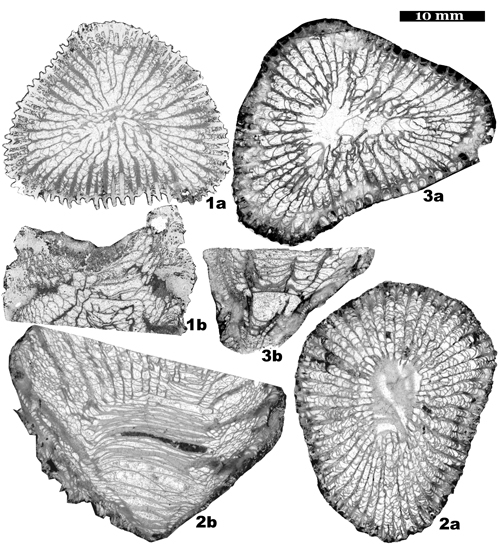
Click on thumbnail to enlarge the image.
Plate 1: Rozkowskaella sandaliformis (, 1980): corallites from the Upper Frasnian set R of Jaźwica quarry in Bolechowice (topotypical material); 1- UAM Tc 1/13, peels taken from the holotype, 1a transverse, 1b longitudinal section; 2- GIUS 402J 039; 3- GIUS 402J 139, with transverse and longitudinal sections.
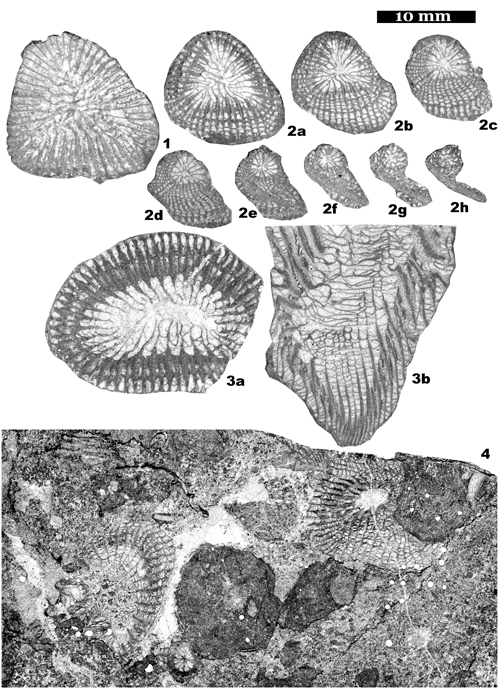
Click on thumbnail to enlarge the image.
Plate 2: Rozkowskaella sandaliformis (, 1980) from the Upper Frasnian: 1-2- GIUS 365G 027 from Grabina quarry: 1- transverse section, slide; 2a-h- peels, taken from a series of 40, to illustrate some details of ontogeny: 2a- peel 01, 2b- peel 10, 2c- peel 16, 2d- peel 22, 2e- peel 26, 2f- peel 30, 2g- peel 34, 2h- peel 36; 3a, 3b- GIUS 388KK 023 from the Kowala quarry, two peels; 4- GIUS 388KK 328, a colony from the latter location, 1st of a series of nine peels, illustrating blastogeny; note transverse section of a metriophyllid tetracoral.
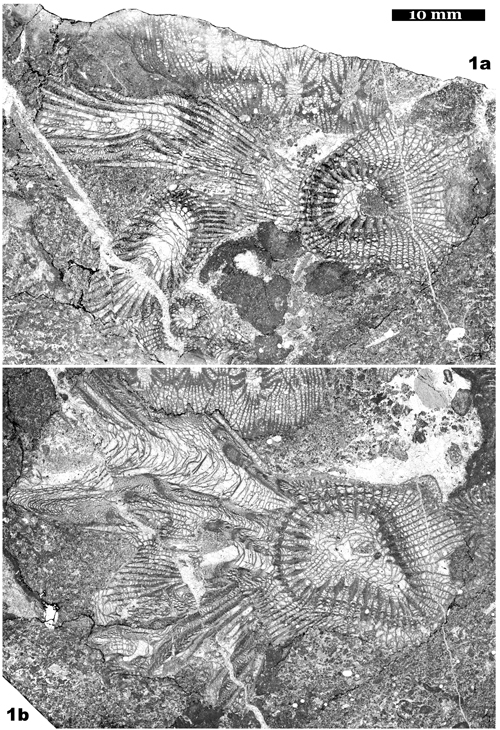
Click on thumbnail to enlarge the image.
Plate 3: Rozkowskaella sandaliformis (, 1980) from the Upper Frasnian of the Kowala quarry, GIUS 388KK 328: 1a, 1b- peels 2p and 3p of a blastogenetic series of nine peels: lateral offsets growing at high angle to large triangular mother corallite; note longitudinal section of a massive phillipsastreid rugosan.
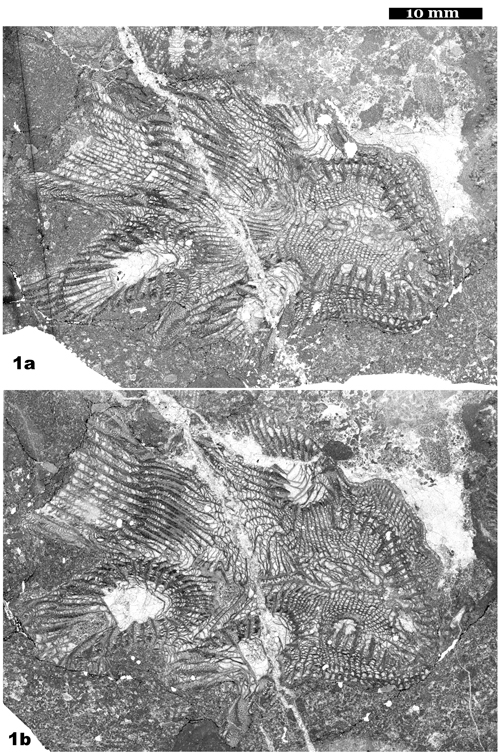
Click on thumbnail to enlarge the image.
Plate 4: Rozkowskaella sandaliformis (, 1980) from the Upper Frasnian of the Kowala quarry, GIUS 388KK 328: 1a, 1b- peels 4Ap and 4p of a blastogenetic series of nine peels: parricidal offsets arising from the large triangular mother corallite.
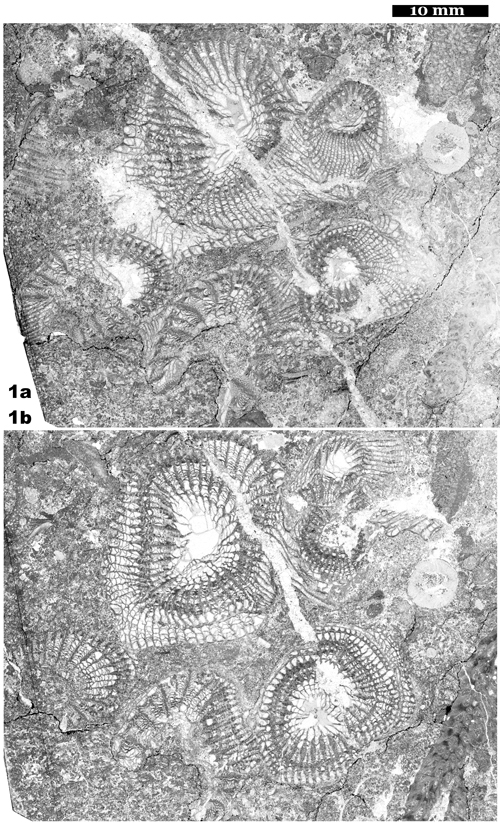
Click on thumbnail to enlarge the image.
Plate 5: Rozkowskaella sandaliformis (, 1980) from the Upper Frasnian of the Kowala quarry, GIUS 388KK 328: 1a, 1b- peels 5p and 6p of a blastogenetic series of nine peels: parricidal offsets increase their size and become obviously triangular in shape; in 1b the upper-right offset probably forms a longitudinal fission.
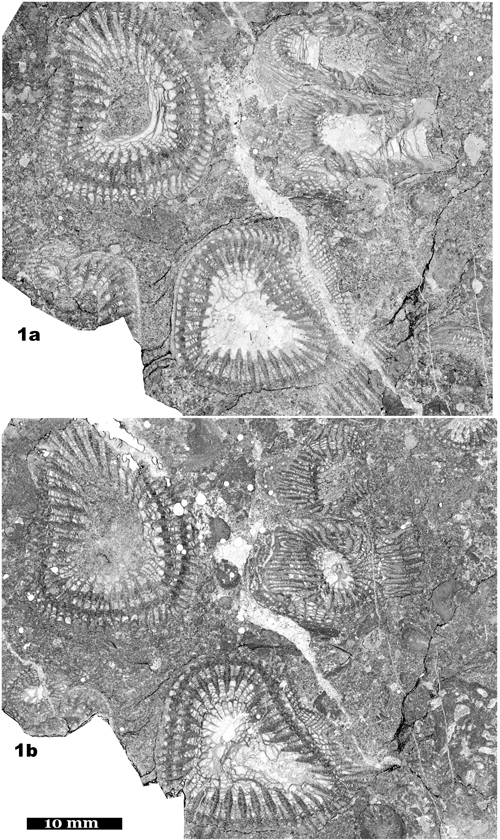
Click on thumbnail to enlarge the image.
Plate 6: Rozkowskaella sandaliformis (, 1980) from the Upper Frasnian of the Kowala quarry, GIUS 388KK 328: 1a, 1b- peels 7p and 8p, the last peels of a blastogenetic series of nine: further increase of size of the parricidal offsets; the lower one develops either rejuvenation or axial offsets.
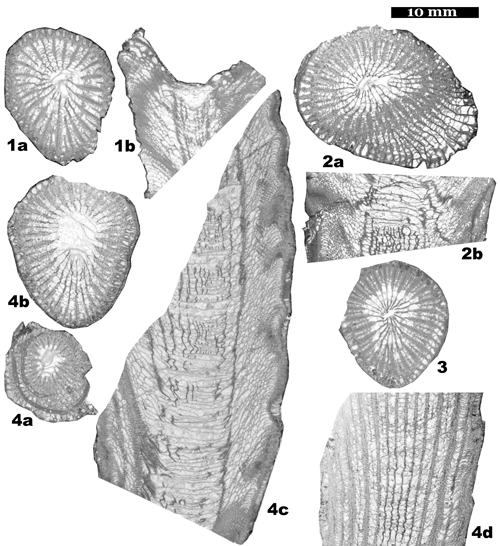
Click on thumbnail to enlarge the image.
Plate 7: Rozkowskaella cf. sandaliformis (, 1980) from the Upper Frasnian of the Kowala quarry: 1a, 1b- GIUS 388KK 022: small rounded-triangular corallite with deeply conical calice and with weakly developed septal eversion; 2a, 2b- GIUS 388KK 046, solitary, with thickened septa and peripheral expansion; no horseshoe dissepiments in longitudinal section; 3- GIUS 388KK 281: rounded-triangular transverse section; 4a-4d- GIUS 388KK 330A, fragmentary corallite with subtriangular traverse cross-section, traces of skeletal overflow in juvenile transverse section and with relatively frequent horseshoe dissepiments, peripheral series of subhorizontal dissepiments, and depressed axial tabellae in longitudinal axial section.
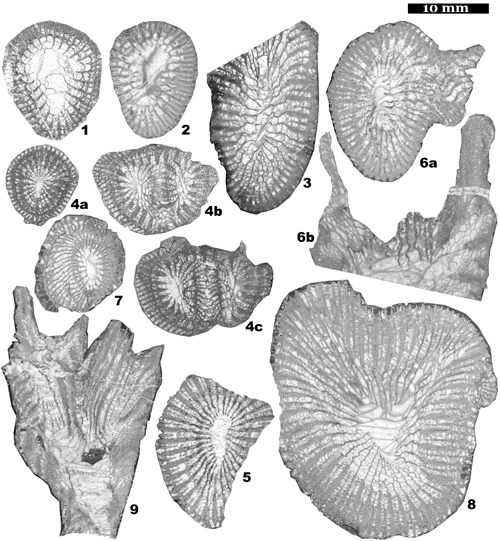
Click on thumbnail to enlarge the image.
Plate 8: Rozkowskaella sp., fragmentary and/or dubious material: 1-2- GIUS 367SC 35A and SC 77: two corallites from the mid-Frasnian of Szczukowskie Górki quarry, with oval to triangular transverse sections - slide (SC 77) and peel (SC 35A); 3-9 - corallites from the Upper Frasnian detrital complex (set G) of the Kowala quarry: 3- GIUS 388KK 028B, oblique section of an oval (?) corallite with horseshoe dissepiments; 4a-4c- GIUS 388KK 069, three peels of rounded-triangular corallite with two axial parricidal offsets; 5- GIUS 388KK 146, fragment of an oval transverse section; 6a, 6b- GIUS 388KK 242, transverse and longitudinal calicinal section of an oval corallite with traces of a lateral offset; 7- GIUS 388KK 248C, oval small corallite with expanded peripheral part and overflowing skeletal tissue at part of its periphery; 8- GIUS 388KK 316, transverse-oblique section of a very large, subtriangular (?) corallite; 9- GIUS 388KK 339B, longitudinal section of a corallite with talon at its base and two axial parricidal offsets visible in its distal part.
Devonian fossil groups described from outcrops listed in the present study of Rozkowskaella, western Holy Cross Mountains, Poland.
| fossil groups | references | Grabina | Jaźwica quarry | Kowala | Szczukowskie G. |
| forams and problematica | & , 1993 | • | • | ||
| Stromatoporoidea | , 1971 | • | • | • | • |
| Tabulata | , 1993 | • | • | • | • |
| , 2012 | • | • | • | • | |
| Rugosa | , 1980 | • | • | ||
| , 1993 | • | • | |||
| & , 1993 | • | • | |||
| Brachiopoda | , 1993b | • | • | ||
| & , 1993 | • | • | • | • | |
| Ostracoda | & , 1993 | • | • | • | |
| Trilobita | , 1993 | • | • | • | |
| Gastropoda | , 2002 | • | • | • | • |
| Tentaculita | , 1993 | • | • | ||
| Crinoidea | , 1993 | • | • | • | • |
| Pisces | & , 1993 | • | • |
The Holy Cross locations, which yielded Rozkowskaella and Rozkowskaella-like corals, with lists of their described tetracoral species, and lists of undescribed genera; numbers in square brackets refer to number of identified specimens.
Grabina: (Fig. 1 ![]() : G) hill with abandoned quarry, about
1 km to the west of Karczówka Hill in Kielce; Devonian strata dip gently to the north and form part of the southern limb of
the Kielce syncline here:
: G) hill with abandoned quarry, about
1 km to the west of Karczówka Hill in Kielce; Devonian strata dip gently to the north and form part of the southern limb of
the Kielce syncline here:
1) thickly-bedded stromatoporoid mid-Frasnian (?) biogenic limestones of the Kowala Fm, of lagoonal origin, form a major part of the Devonian sequence here, with scarce rugose corals [~10], among them there are Disphyllum sp. [2], Hexagonaria sp. [1], Macgeea or Thamnophyllum sp. [8];
2) they are overlain by massive biogenic limestones of the Kowala Fm, locally with rock-forming Renalcis and stromatoporoids, forming an organic buildup at this site; the rugose corals are rare [~20] also in this interval and contain disphyllids S. aiense liujingense [3 - & 1993] and Marisastrum sp. [1] and endophyllids Tabulophyllum sp. [8];
3) at the top of the sequence, there are to be seen a few meters of detrital-biogenic limestones, with an abundant and diverse benthic fauna indicating a fore-reef, open-marine setting; rugose corals, with common Upper Frasnian taxa, are extremely numerous here [~200]; so far Rozkowskaella sandaliformis [1] has been illustrated by and (1991), and Smithicyathus lacunosus / cf. lacunosus [9] by (2007); along with other common rugosans, there are endophyllids Hankaxis sp. [24] and Tabulophyllum sp. [11], phillipsastreids Baculophyllum [>20], various species of Frechastraea [50], Phillipsastrea [62] and a Scruttonia sp. [1];
4) pelitic to finely-detrital limestones have been collected locally in the central part of Grabina quarry, possibly from infilling of a neptunian dyke at this site; the age of its infilling must be, at least partly, Famennian, as indicated by the presence of a heterocoral Oligophylloides pachythecus in one sample.
Jaźwica quarry: (Fig. 1 ![]() : J) large active quarry at Łgawa Hill in Bolechowice, exploiting Devonian dolomites and limestones;
an important reference section for the southern facies belt of the Holy Cross Devonian (
1993a); some rugose corals were described or listed by
(1980), (1982,
1993 - mostly from the Kowala Fm) and
and
(1991); notable, there are also abundant siliceous sponges ( et al.,
2001) in the marly Upper Frasnian - point 5 below:
: J) large active quarry at Łgawa Hill in Bolechowice, exploiting Devonian dolomites and limestones;
an important reference section for the southern facies belt of the Holy Cross Devonian (
1993a); some rugose corals were described or listed by
(1980), (1982,
1993 - mostly from the Kowala Fm) and
and
(1991); notable, there are also abundant siliceous sponges ( et al.,
2001) in the marly Upper Frasnian - point 5 below:
1) marly limestones of the Jaźwica Member / Kowala Formation, Upper Givetian in age, a few meters thick, represent an intra-shoal deep setting; their rugosans have been described by (1993): Temnophyllum occidentale [13], T. menyouenese [2], Temnophyllum zamkowae [2] and Temnophyllum sp. [4];
2) the successive unit, consisting of biogenic stromatoporoid-coral limestones of the Kowala Fm, is a hundred or so meters thick, and originated in a shallow lagoon; the rugose corals are here usually dispersed, with notable exception for the Hexagonaria davidsoni biostrome at its base, and some Disphyllum banks in the lower part of the interval; its disphyllid rugose corals have been listed and/or illustrated by (1993): Disphyllum cylindricum [4], Disphyllum wirbelauense [8], Disphyllum sp. [3], Hexagonaria davidsoni [37], Temnophyllum cf. latum [1], T. occidentale [1] and Temnophyllum sp [1];
3) massive to biohermal limestones of the Kadzielnia Member / Kowala Formation, representing a mud-mound, with a major contribution of stromatoporoids and corals, with disphyllids and a phillipsastreid listed and/or illustrated by (1993): Disphyllum cylindricum [2], D. wirbelauense [1], Disphyllum sp. [7], Hexagonaria kowalae [7], Temnophyllum cf. [1] and Macgeea sp. [2];
4) detrital limestones of the mid-Frasnian, cap the Kowala Fm in the central, poorly accessible part of the Jaźwica quarry and yielded about 10 coralla of Disphyllum sp. [1], Macgeea spp. [5] and Phillipsastrea spp. [4];
5) marly limestones, Upper Frasnian in age, yielded in the years 1970-1980 an abundant silicified benthic fauna, naturally weathered out at the top of the Łgawa Hill; since that time however, the site has been used as a waste-dump for the Jaźwica quarry, and thus it was inaccessible for study; the illustrated corals are Aristophyllum irenae, Piceaphyllum pronini, Tabulophyllum simile by (1980), Diffusolasma diffusum by (1982, 1993) and Rozkowskaella sandaliformis by and (1991); among hundreds of other rugosans few were sectioned and include a single corallite of the endophyllid Hankaxis sp. and a few colonial phillipsastreids with Frechastraea spp. [7] and Phillipsastrea spp. [10].
Kowala quarry: (Fig. 1 ![]() : KK)
a large active and still expanding quarry (as in 2014), directly to the south of Kowala village, exploting the Givetian to Famennian carbonates for the cement factory at Nowiny; Devonian strata form part of the southern limb of Gałęzice-Bolechowice syncline here, and dip ca 30° to the north:
: KK)
a large active and still expanding quarry (as in 2014), directly to the south of Kowala village, exploting the Givetian to Famennian carbonates for the cement factory at Nowiny; Devonian strata form part of the southern limb of Gałęzice-Bolechowice syncline here, and dip ca 30° to the north:
1) biogenic limestones of the Kowala Formation, including the biohermal Kadzielnia Member, are the major interval exploited in this quarry, and are thus poorly accessible; they contain abundant shallow-marine to lagoonal fossils, possibly of the Lower Frasnian, with stromatoporoids dominating; among the rugose corals there are Disphyllum kweihsiense [2], listed by (1993, p. 231), Hexagonaria kowalae [44], described by the latter (with numerous colonies from subsequent sampling), and Thamnophyllum sp. [2];
2) detrital limestones cap the biogenic Kowala Formation, their mid-Frasnian part contains Spinophyllum sp. [1], Temnophyllum sp. [1], and Phillipsastrea sp. [2];
3) upper part of the detrital limestones (Kowala set G of 1993a) contains abundant and diverse Upper Frasnian benthic fossils, indicating an open-marine, fore-reef setting; among almost 400 sectioned corals of this interval described were so far Smithicyathus lacunosus [16], and S. cf. lubliniensis [1] (2007); the other corals include endophyllids Hankaxis spp. [11], Tabulophyllum spp. [~80], and Tarphyphyllum spp. [~30], phillipsastreids Frechastraea spp. [~60], Macgeea spp. [11], Phillipsastrea spp. [~130], and cf. Thamnophyllum [1];
4) the deeper-offshore, marly sedimentation started in the Upper(most) Frasnian and continued well into Famennian; these marls and shales, with a total thickness of about 150m, contain in their lowermost part (few meters thick) the siliceous sponges ( et al., 2001), and the rugose corals of the Upper Frasnian with disphyllid Diffusolasma sp. [2], and endophyllid Tabulophyllum sp. [2];
5) a major part of the marly-shaly sequence of the Kowala quarry is Famennian to Tournaisian in age, and contains two (or possibly three) horizons with corals (see , 2002, p. 46); about 50 specimens collected here by the present author, are in the course of investigation by Błażej ; to note is presence of a heterocoral Oligophylloides sp. [1] in the mid-Famennian part of this interval.
Szczukowskie Górki: (Fig. 1 ![]() : SC)
an active quarry in Szczukowskie Górki village, about 1 km to the west of Grabina; biogenic limestones of the Kowala Formation contain mid-Frasnian rugose corals, with Spinophyllum aiense liujingense illustrated by
and
(1993), and with disphyllids cf. Hexagonaria [9], Kuangxiastraea sp. [6], endophyllids Tabulophyllum spp. [7], and phillipsastreids: Rozkowskaella sp. [2], Macgeea sp. [4], cf. Peneckiella [1], cf. Phillipsastrea [6], and Thamnophyllum sp. [4].
: SC)
an active quarry in Szczukowskie Górki village, about 1 km to the west of Grabina; biogenic limestones of the Kowala Formation contain mid-Frasnian rugose corals, with Spinophyllum aiense liujingense illustrated by
and
(1993), and with disphyllids cf. Hexagonaria [9], Kuangxiastraea sp. [6], endophyllids Tabulophyllum spp. [7], and phillipsastreids: Rozkowskaella sp. [2], Macgeea sp. [4], cf. Peneckiella [1], cf. Phillipsastrea [6], and Thamnophyllum sp. [4].